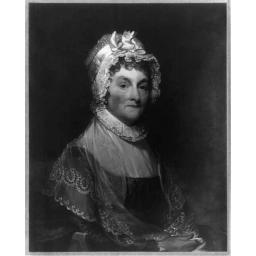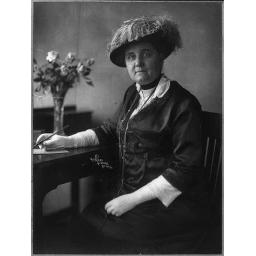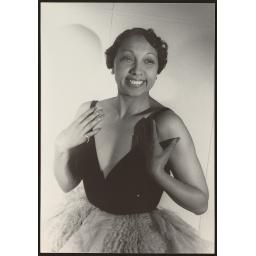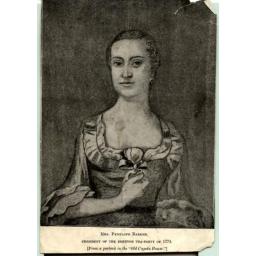Susan Brownell Anthony
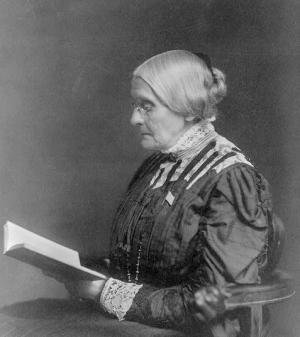
Champion of temperance, abolition and African American rights, the rights of labor, and equal pay for equal work, Susan Brownell Anthony ultimately became one of the most visible leaders of the women’s suffrage movement in the 19th century. Partnering with Elizabeth Cady Stanton, Anthony traveled the country delivering speeches (many of them written by Stanton) and risking arrest in the name of women’s suffrage by attempting to vote.
Born February 15, 1820, in Adams, Massachusetts, the second of Daniel and Lucy Read Anthony’s eight children. Anthony’s father was from a long line of farmers, though when she was six he opened a cotton mill. Her legacy on her mother’s side included soldiers in the American Revolution and Massachusetts legislators. Anthony was raised in a Quaker family, where women were considered equal with men under God. From an early age, Anthony made her life's work one of justice and sought to establish equality in the larger world. Anthony never married and became a teacher. After teaching for many years, she returned to the family farm. There, she met many activists, who visited her family, including abolitionists William Lloyd Garrison and Frederick Douglass. This piqued her interest in reform and she became involved in the temperance and anti-slavery movements. Some abolitionists prevented women from speaking publicly, seeing it as unsuited to their feminine roles. Garrison encouraged women’s full participation and Anthony gave frequent and fiery speeches on behalf of ending slavery.
Although she did not attend the first women’s rights convention at Seneca Falls in 1848 (though her mother and sister did), Anthony would join, and become a pivotal leader of, the women’s rights and suffrage movement within a few years. She met Elizabeth Cady Stanton in 1851 and the two formed a fast friendship and alliance that dominated the movement and lasted for more than 50 years. A skilled political strategist, Anthony strengths were discipline, energy, and organization. In 1853, she joined the New York effort to gain property rights for married women. Anthony and Stanton co-founded the American Equal Rights Association and in 1868 the two women became editors of its newspaper, The Revolution. Anthony hit the lecture circuit for six years to finance the newspaper and suffrage campaigns.
In 1869, Anthony and Stanton opposed the 14th and 15th amendments to the US Constitution, which gave voting rights to black men but did not extend the franchise to women. Their stance led to a rift with other women’s suffragists. Consequently, the pair founded the National Woman Suffrage Association, seeking a constitutional amendment guaranteeing women’s right to vote. Anthony was arrested for voting in 1872 and was tried and convicted, a move that brought national attention to the suffrage cause. She also led a women’s protest at the 1876 Centennial delivering a "Declaration of Rights" written by Stanton and Matilda Gage. She wrote and published, with Stanton and Gage the comprehensive History of Woman Suffrage (1881-1885).
By 1888, Anthony helped with the re-unification of the suffrage associations, which fused under the new banner of National American Woman Suffrage Association. She presided over this group until 1900. Anthony gathered signatures on suffrage petitions at the state and national levels and undertook arduous state tours to organize suffrage campaigns in the states and nationally. Called “The Napoleon of the woman’s rights movement,” Anthony lobbied yearly before Congress. She remained active in the movement until her death in 1906, 14 years before women received the right to vote. The 19th Amendment, which safeguards women’s right to vote, was nicknamed in her honor, the Susan B. Anthony Amendment.
Edited by Debra Michals, Ph.D.
2017
- Anthony, Susan. “Declaration of Rights of the Women of the United States by the National Woman Suffrage Association, July 4th, 1876.” The Elizabeth Cady Stanton & Susan B. Anthony Papers Project. http://ecssba.rutgers.edu/docs/decl.html. Accessed May 2016.
- “Biography of Susan B. Anthony.” National Susan B. Anthony Museum & House. http://susanbanthonyhouse.org/her-story/biography.php. Accessed May 2016.
- Lange, Allison. “Suffragist Organize: National Woman Suffrage Association.” National Women’s History Musuem. http://www.crusadeforthevote.org/nwsa-organize/. Accessed May 2016.
- Lange, Allison. “Suffragist Unite: National American Woman Suffrage Association.” National Women’s History Museum. http://www.crusadeforthevote.org/nawsa-united/. Accessed May 2016.
- Mayo, Edith. “Rights for Women: The Suffrage Movement and Its Leaders.” National Women’s History Museum. https://www.nwhm.org/online-exhibits/rightsforwomen/index.html. Accessed May 2016.
- “Susan B. Anthony.” National Park Service. https://www.nps.gov/wori/learn/historyculture/susan-b-anthony.htm. Accessed May 2016.
- PHOTO: Library of Congress
MLA – Michals, Debra. “Susan B. Anthony.” National Women’s History Museum, 2017. Date accessed.
Chicago – Michals, Debra “Susan B. Anthony.” National Women’s History Museum. 2017. www.womenshistory.org/education-resources/biographies/susan-brownell-anthony.
Web Sites:
- Crusade for the Vote, National Women's History Museum
- Rights for Women, National Women's History Museum
- Susan B. Anthony House
- 1873 Speech of Susan B. Anthony on woman suffrage
- Susan B. Anthony House, National Park Service
- Susan B. Anthony, National Women's Hall of Fame
- Papers of Elizabeth Cady Stanton and Susan B. Anthony Project
- Public Broadcasting System (PBS) - "Not For Ourselves Alone: The Story of Elizabeth Cady Stanton and Susan B. Anthony"
- Trial of Susan B. Anthony
Books:
- Anthony, Susan B. The Trial of Susan B. Anthony (Humanity Books, 2003).
- Anthony, Katherine Susan. Susan B. Anthony: Her Personal History and Her Era (Russell & Russell, 1975).
- Barry, Kathleen. Susan B. Anthony: A Biography of a Singular Feminist (Authorhouse, 2000).
- Dubois, Ellen Carol. The Elizabeth Cady Stanton-Susan B. Anthony Reader: Correspondences, Writings and Speeches (Boston: Northeaster University Press, 1992).
- Harper, Ida. Life and Work of Susan B. Anthony (Beaufort books - 3 volume set).
- Isaacs, Sally Senzell. America in the Time of Susan B. Anthony: The Story of Our Nation from Coast to Coast (Heinemann Library, 2000).
- Monsell, Helen Albee. Susan B. Anthony: Champion Women's Rights (Aladdin, 1986).
- Sherr, Lynn. Failure is Impossible: Susan B. Anthony in Her Own Words (Three Rivers Press, 1996).
- Stanton, Elizabeth Cady, Ann De Gordon, and Susan B. Anthony. Selected Papers of Elizabeth Cady Stanton and Susan B. Anthony: In the School of Anti-Slavery, 1840-1866 (Rutgers, NJ: Rutgers University Press, 1997).
- Ward, Geoffery C. and Ken Burns. Not For Ourselves Alone: The Story of Elizabeth Cady Stanton and Susan B. Anthony (Knopf, 2001).

